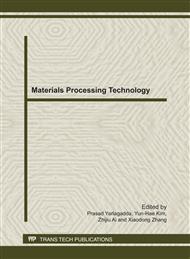p.323
p.328
p.332
p.336
p.340
p.346
p.350
p.354
p.358
The Influence of Welding Speed for Aluminum 6063 and Aluminum 7075 by the Friction Stirs Welding
Abstract:
The main purpose of this paper to application of a friction stirs welding. In an aluminum alloy rolled sheet, grade 6063 and 7075 by variables parameter feed welding speed after that the specimen are taken tensile strength test and macro structure. In summary, the results showed parameter to make major changes to the weld is incomplete and welding defects when the speed feed not appropriate. But still result in the metal welded. There is strong evidence that higher than the base material. The position of the damage caused by testing the strength of the weld the base aluminum 6063 which is the metal with a lower strength compared to base aluminum 7075. Conditions to provide the maximum strength is 108 MPa for the 1000 rpm speed, a welding speed 100 mm / min
Info:
Periodical:
Pages:
340-345
Citation:
Online since:
September 2011
Authors:
Price:
Сopyright:
© 2011 Trans Tech Publications Ltd. All Rights Reserved
Share:
Citation:


